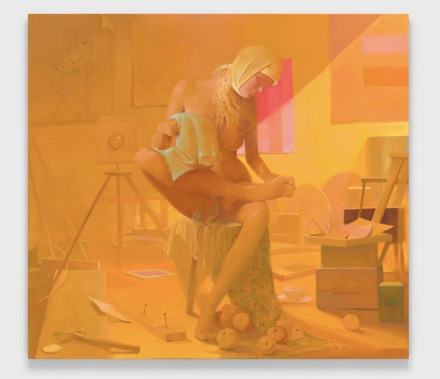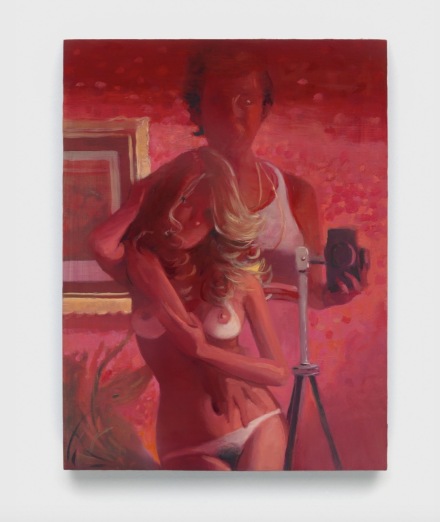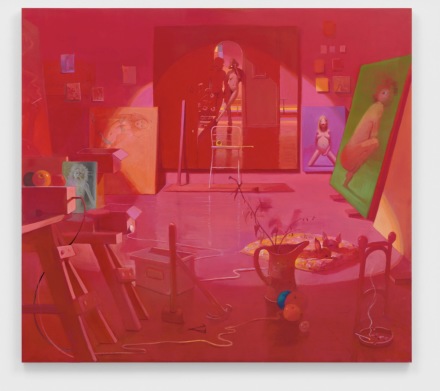
Lisa Yusakavage, Yellow Studio (2021), via David Zwirner
On view now at David Zwirner’s 19th Street location in New York, artist Lisa Yuskavage marks her seventh solo exhibition at the gallery with a selection of new work that sees the artist continuing to mine her surreal approach to figuration, and her expression capacity for charging scenes with a latent tension complicated by notions of sexuality, the body, and society.

Lisa Yuskavage, Red Photo Shoot (2020), via David Zwirner
For more than thirty years, Yuskavage’s highly original approach to figurative painting has challenged conventional understandings of the genre. Her simultaneously bold, eccentric, exhibitionist, and introspective characters assume dual roles of subject and object, complicating the position of viewership. At times playful and harmonious, and at other times rueful and conflicted, these characters are cast within fantastical compositions in which realistic and abstract elements coexist and color determines meaning. While the artist’s painterly techniques evoke art-historical precedents, her motifs are often inspired by popular culture, creating an underlying dichotomy between high and low and, by implication, sacred and profane, harmony and dissonance.

Lisa Yusakavage, Pink Studio (Rendezvous) (2021), via David Zwirner
In this exhibition, Yuskavage continues her long-standing exploration of what constitutes a model, exceptionally summoning the history of her own work as part of that process. Its two rooms are defined by contrasting moods that the artist has often intertwined within individual paintings, and which both engage with aspects of art making. The first includes a group of works that confront the viewer on varied levels, recalling the tension between seer and seen. Addressing issues of vulnerability, power, and rage, her works draw on complicated tensions and visually lush landscapes, often using deep color fields to saturate her works with a latent tension.

Lisa Yusakavage, Pink Studio (Rendezvous) (2021), via David Zwirner
Taking their point of departure in Henri Matisse’s The Red Studio (1911) and The Pink Studio (1911), Yuskavage delves into the theatrical and the dramatic, presenting subjects that seem to surge forth from the dense color. In the more than three-meter-long Night Classes at the Department of Painting Drawing and Sculpture (2018–2020), faintly visible subjects were pulled out from the pentimenti of a deep cadmium red, yielding a dramatic yet lighthearted scene with a model and two nude students examining each other in a dreamlike state after hours. The palette and a configuration of artworks within the room specifically recall Matisse’s aforementioned studio interiors, yet also juxtapose the modernist’s desire for flatness and abstraction with deep shadows and minute attention to realistic detail—treating color as round and three-dimensional. One of her earliest works, The Ones That Don’t Want To: Bad Baby (1992), is displayed on the back wall—the almost monochromatic painting with its angry-looking model layered into a new, fictive whole.
Throughout, the notions of power and anger are always at the back of the mind, complicating the act of looking with a sense of confrontation that challenges the viewer to contemplate both their perception of the work, and the act of seeing.
The show closes October 23rd.
Read more:
Lisa Yuskavage [Exhibition Site]



